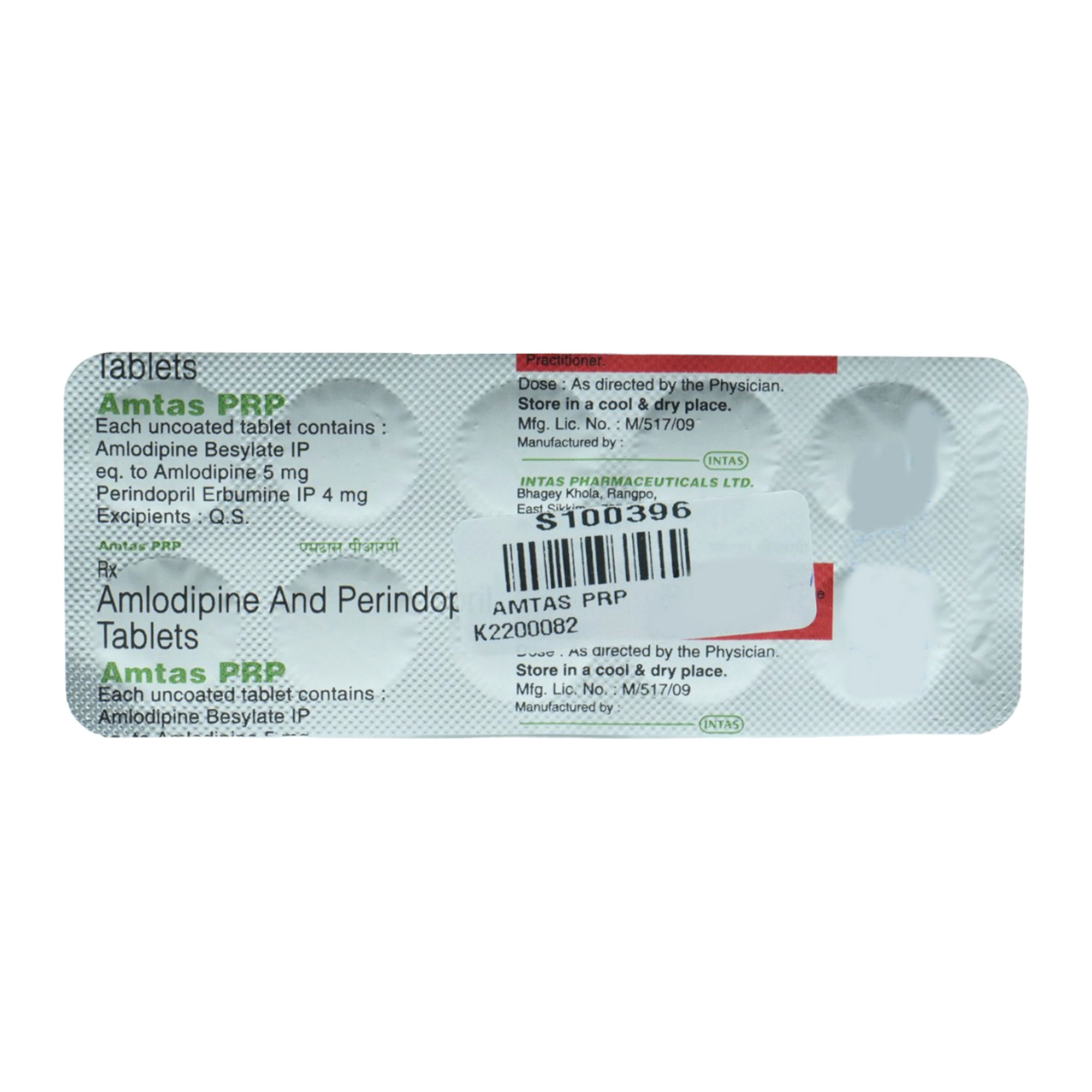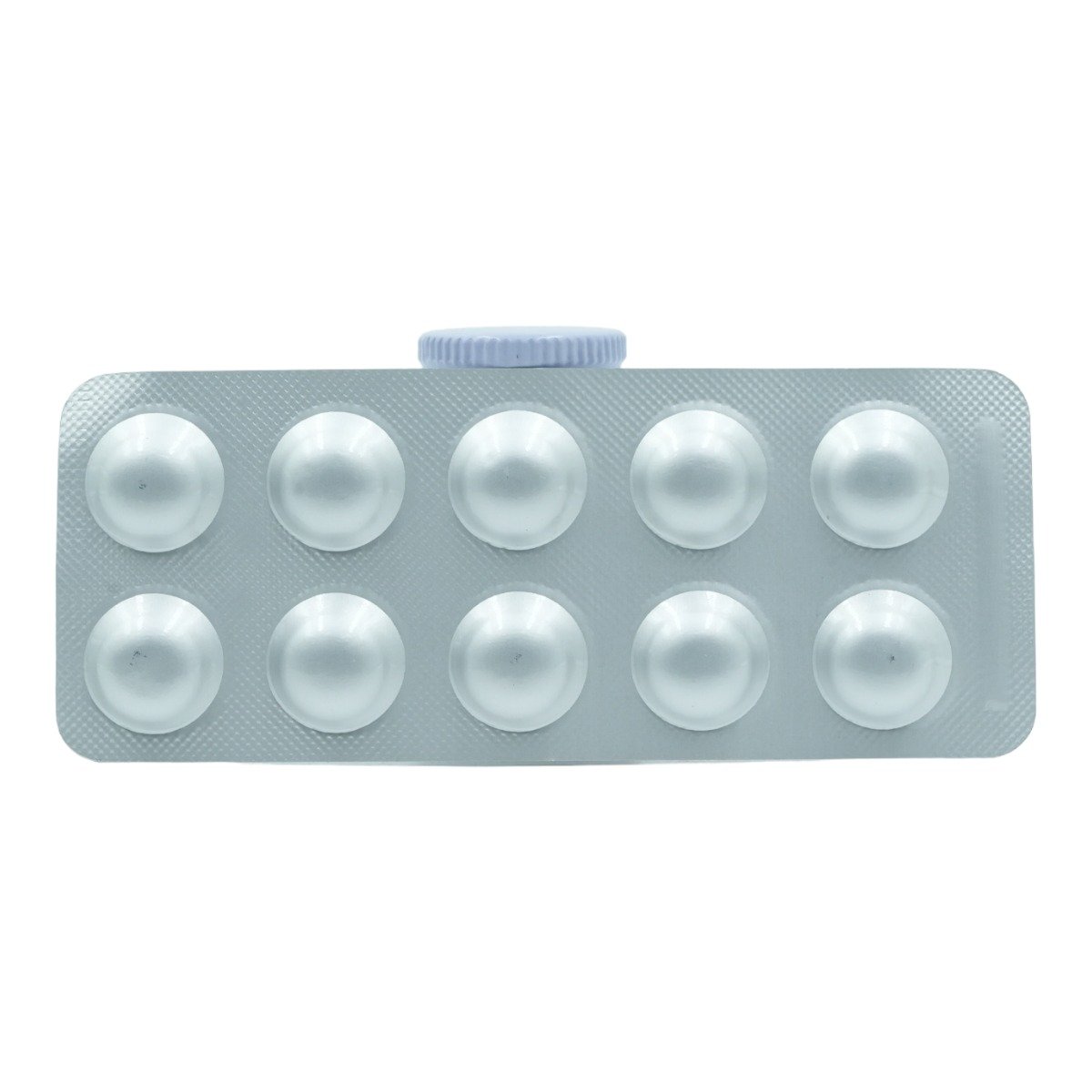Amtas PRP Tablet


MRP ₹175
(Inclusive of all Taxes)
₹26.3 Cashback (15%)
know your delivery time
Provide Delivery Location
Composition :
Manufacturer/Marketer :
Consume Type :
Expires on or after :
Return Policy :

Secure Payment

Trusted by 8 Crore Indians

Genuine Products
Therapeutic Class
Country of origin
Manufacturer/Marketer address
Author Details
We provide you with authentic, trustworthy and relevant information
Disclaimer
Alcohol
Safe if prescribed
Avoid consuming alcohol as it might cause increased dizziness.
Pregnancy
Consult your doctor
Amtas PRP Tablet is not recommended during early pregnancy and should not be taken when more than 3 months pregnant as it may cause serious harm to the baby. Please consult your doctor if you are pregnant, think you are pregnant or planning for pregnancy.
Breast Feeding
Consult your doctor
Amtas PRP Tablet is not recommended for breastfeeding mothers. Talk to your doctor if you have any concerns.
Driving
Safe if prescribed
Amtas PRP Tablet may cause dizziness, do not drive or operate heavy machinery if you feel dizzy.
Liver
Consult your doctor
Dose adjustment may be needed. Please consult your doctor if you have liver problems or any concerns regarding this. Avoid taking Amtas PRP Tablet if you have severe liver disease or hepatic encephalopathy.
Kidney
Consult your doctor
Dose adjustment may be needed. Avoid taking Amtas PRP Tablet if you have severe kidney problems. Please consult your doctor if you have kidney problems or any concerns regarding this.
Children
Safe if prescribed
Amtas PRP Tablet is not recommended for children as safety and effectiveness have not been established.
Product Substitutes
About Amtas PRP Tablet
Amtas PRP Tablet belongs to the group of anti-hypertensive medicines used to treat high blood pressure (hypertension). Additionally, it is also used to treat stable coronary artery disease. High blood pressure is a condition in which the blood exerts increased pressure on the walls of blood vessels. Stable coronary artery disease is a condition in which the blood supply to the heart is blocked or reduced.
Amtas PRP Tablet is a combination of two drugs, namely: Amlodipine and Perindopril erbumine. Amlodipine relaxes the blood vessels, thereby improves blood flow. Perindopril erbumine widens the blood vessels, making it easier for the heart to pump blood through them. Together, Amtas PRP Tablet helps lower the blood pressure, thereby reduces the chances of heart problems such as heart attack and stroke.
You are advised to take Amtas PRP Tablet for as long as your doctor has prescribed it for you, depending on your medical condition. In some cases, you may experience certain common side effects such as oedema, headache, dizziness, nausea, and abdominal pain. Most of these side effects do not require medical attention and will resolve gradually over time. However, you are advised to talk to your doctor if the side effects persist or worsen.
Amtas PRP Tablet is not recommended during early pregnancy and should not be taken when more than 3months pregnant as it may cause serious harm to the baby. Amtas PRP Tablet is not recommended for breastfeeding mothers and children. Amtas PRP Tablet may cause dizziness, so drive with caution. Avoid consuming alcohol as it might cause increased dizziness. Inform your doctor about all the medicines you are taking and your health condition to rule out any unpleasant side effects.
Uses of Amtas PRP Tablet
Medicinal Benefits Mweb
Key Benefits
Amtas PRP Tablet is a combination of two drugs, namely: Amlodipine and Perindopril erbumine. Amtas PRP Tablet belongs to the group of anti-hypertensive medicines used to treat high blood pressure (hypertension) and/or stable coronary artery disease. Amlodipine is a calcium channel blocker that relaxes the blood vessels, thereby improving blood flow. Perindopril erbumine is an angiotensin-converting enzyme inhibitor that widens the blood vessels; this makes it easier for the heart to pump blood through them. Together, Amtas PRP Tablet helps treat hypertension, thereby reducing the chances of heart problems such as heart attack and stroke.
Directions for Use
Side Effects of Amtas PRP Tablet
- Oedema
- Headache
- Dizziness
- Flushing
- Light-headedness due to low blood pressure
- Tiredness
- Weakness
- Nausea
- Vomiting
Drug Warnings
Do not take Amtas PRP Tablet if you are allergic to any of its contents; if you have angioedema, severe water retention, low blood pressure, or low blood potassium. Inform your doctor if you have diabetes, heart problems, gout, parathyroid gland problems, heart failure, collagen disease, atherosclerosis (hardening of arteries), excess acid in the blood, liver/kidney problems, if you are on a low-salt diet, if you are taking lithium/potassium-sparing diuretics, or if you are taking any other blood pressure-lowering medicines. Amtas PRP Tablet is not recommended during early pregnancy and should not be taken when more than 3 months pregnant as it may cause serious harm to the baby. Amtas PRP Tablet is not recommended for breastfeeding mothers and children. Amtas PRP Tablet may cause dizziness, so drive with caution. Keep your doctor informed about your health condition and medications to rule out any interactions.
Drug-Drug Interactions
Drug-Drug Interactions
Login/Sign Up
Using Amtas PRP Tablet together with dantrolene may increase the risk of hyperkalemia (high blood potassium).
How to manage the interaction:
Taking Amtas PRP Tablet with Dantrolene can cause an interaction, consult a doctor before taking it. You should seek medical attention if you experience nausea, vomiting, weakness, confusion, tingling of the hands and feet, a weak pulse, or a slow or irregular heartbeat. Do not stop using any medications without talking to a doctor.
Combining Aliskiren with Amtas PRP Tablet can increase the risk of low blood pressure, high potassium levels, and kidney damage.
How to manage the interaction:
Taking Amtas PRP Tablet with Aliskiren is not recommended, but can be taken if prescribed by a doctor. However, if you experience nausea, vomiting, weakness, confusion, tingling of the hands and feet, feelings of heaviness in the legs, a weak pulse, or a slow or irregular heartbeat contact your doctor immediately. Do not discontinue any medications without consulting a doctor.
Using Amtas PRP Tablet and mitotane together may drastically lower Amtas PRP Tablet blood levels, which makes the medicine less effective.
How to manage the interaction:
Although co-administration of Amtas PRP Tablet with mitotane can result in an interaction, it can be taken if a doctor has advised it. Do not discontinue any medications without consulting a doctor.
Using phenobarbital and Amtas PRP Tablet may drastically lower Amtas PRP Tablet blood levels, which makes the medicine less effective.
How to manage the interaction:
Although co-administration of phenobarbital with Amtas PRP Tablet can result in an interaction, it can be taken if a doctor has advised it. Do not discontinue any medications without consulting a doctor.
Coadministration of Amtas PRP Tablet and carbamazepine together may significantly reduce Amtas PRP Tablet blood levels, making the medicine less effective.
How to manage the interaction:
Although there is an interaction between Amtas PRP Tablet with carbamazepine, it can be taken if a doctor has advised it. However, if you experience any unusual symptoms contact the doctor immediately. Do not stop using any medications without talking to a doctor.
Using Amtas PRP Tablet and phenytoin together may drastically lower Amtas PRP Tablet blood levels, which makes the medicine less effective.
How to manage the interaction:
Although Amtas PRP Tablet with phenytoin can result in an interaction, it can be taken if a doctor has advised it. Do not discontinue any medications without consulting a doctor.
Using Amtas PRP Tablet and primidone together may lower Amtas PRP Tablet blood levels, which makes the medicine less effective.
How to manage the interaction:
Although co-administration of Amtas PRP Tablet with primidone can result in an interaction, it can be taken if a doctor has advised it. Do not discontinue any medications without consulting a doctor.
Coadministration of lemborexant and Amtas PRP Tablet may increase the blood levels of lemborexant.
How to manage the interaction:
Although co-administration of Amtas PRP Tablet with Lemborexant can result in an interaction, it can be taken if a doctor has advised it. However, consult your doctor if you experience abnormal sleep patterns, worsening of depression, changes in heartbeat, or headache. Do not discontinue any medications without consulting a doctor.
Taking simvastatin with Amtas PRP Tablet may result in considerably higher blood levels of simvastatin and may increase the risk of side effects (liver damage and rhabdomyolysis - an uncommon but serious illness characterized by the breakdown of skeletal muscle tissue).
How to manage the interaction:
Although taking Amtas PRP Tablet with simvastatin can result in an interaction, it can be taken if a doctor has advised it. If you have unexplained muscular pain, soreness, or weakness while using simvastatin, especially if these symptoms are accompanied by fever or dark-colored urine, consult the doctor immediately. However, if you develop a fever, chills, joint pain or swelling, unusual bleeding or bruising, skin rash, itching, loss of appetite, fatigue, nausea, vomiting, dark colored urine, and/or yellowing of the skin or eyes, consult the doctor. Do not stop using any medications without a doctor's advice.
Co-administration of Amtas PRP Tablet can make Sirolimus may increase the risk of angioedema (a condition associated with swelling of the face, eyes, lips, tongue, throat, and occasionally also the hands and feet).
How to manage the interaction:
There may be a possibility of interaction between Amtas PRP Tablet and Sirolimus, but it can be taken if prescribed by a doctor. However, consult the doctor if you notice any swelling of the face, eyes, lips, tongue, throat, hands and feet or have trouble breathing or swallowing. Do not stop using any medications without a doctor's advice.
Drug-Food Interactions
Drug-Food Interactions
Login/Sign Up
Lentils, Orange Juice, Oranges, Raisins, Potatoes, Salmon Dried, Spinach, Sweet Potatoes, Tomatoes, Coconut Water, Beans, Beetroot, Broccoli, Bananas, Apricots, Avocado, Yogurt
How to manage the interaction:
Taking Amtas PRP Tablet with potassium-containing salt substitutes or potassium supplements can cause high levels of potassium in the blood. Avoid taking potassium-containing salt substitutes or potassium supplements while being treated with Amtas PRP Tablet.
Drug-Diseases Interactions
Drug-Diseases Interactions
Login/Sign Up
Drug-Drug Interactions Checker List
- LITHIUM
- DANTROLENE
- ESTRAMUSTINE
- SACUBITRIL+VALSARTAN
- TRIAMTERENE
- AMILORIDE
- ALISKIREN
- HEPARIN
- TRIMETHOPRIM+SULFAMETHOXAZOLE
- EPLERENONE
- SPIRONOLACTONE
Habit Forming
Special Advise
- Regular monitoring of blood pressure levels, kidney function and electrolyte levels while taking Amtas PRP Tablet is advised.
- If you are due to undergo any surgery, inform the doctor that you are taking Amtas PRP Tablet .
Diet & Lifestyle Advise
- You are advised to consume low salt and low-fat diet.
- Regular exercise is also recommended.
- Eat a diet rich in whole grains, vegetables, and fruits.
- Avoid smoking and alcohol consumption.
- Maintain a healthy weight with proper diet and exercise.
- Practice meditation or yoga as it helps in managing stress.
All Substitutes & Brand Comparisons
RX
Out of StockCardiomart AP 5mg/4mg Tablet
₹150
(₹13.5 per unit)
14% CHEAPERRX
Out of StockRindopril AM Tablet
₹150.7
(₹13.56 per unit)
13% CHEAPER

Have a query?
Buy best Cardiology products by
Torrent Pharmaceuticals Ltd
Sun Pharmaceutical Industries Ltd
Lupin Ltd
Intas Pharmaceuticals Ltd
Cipla Ltd
Micro Labs Ltd
Macleods Pharmaceuticals Ltd
Abbott India Ltd
Ajanta Pharma Ltd
Ipca Laboratories Ltd
Eris Life Sciences Ltd
Mankind Pharma Pvt Ltd
Lloyd Healthcare Pvt Ltd
Dr Reddy's Laboratories Ltd
Glenmark Pharmaceuticals Ltd
Emcure Pharmaceuticals Ltd
Alembic Pharmaceuticals Ltd
Alkem Laboratories Ltd
East West Pharma India Pvt Ltd
USV Pvt Ltd
Zydus Healthcare Ltd
Aristo Pharmaceuticals Pvt Ltd
Elbrit Life Sciences Pvt Ltd
J B Chemicals & Pharmaceuticals Ltd
Zydus Cadila
Akumentis Healthcare Ltd
Alteus Biogenics Pvt Ltd
Hbc Life Sciences Pvt Ltd
Fusion Health Care Pvt Ltd
Troikaa Pharmaceuticals Ltd
La Renon Healthcare Pvt Ltd
Corona Remedies Pvt Ltd
Jubilant Lifesciences Ltd
Medley Pharmaceuticals Ltd
Knoll Healthcare Pvt Ltd
Msn Laboratories Pvt Ltd
Zuventus Healthcare Ltd
Cadila Pharmaceuticals Ltd
Blue Cross Laboratories Pvt Ltd
Lividus Pharmaceuticals Pvt Ltd
Morepen Laboratories Ltd
Ranmarc Labs
Shrrishti Health Care Products Pvt Ltd
Sanofi India Ltd
Steris Healthcare
Elder Pharmaceuticals Ltd
Primus Remedies Pvt Ltd
Unison Pharmaceuticals Pvt Ltd
Eswar Therapeutics Pvt Ltd
Knoll Pharmaceuticals Ltd
Tas Med India Pvt Ltd
Systopic Laboratories Pvt Ltd
Indiabulls Pharmaceuticals Pvt Ltd
Leeford Healthcare Ltd
Sinsan Pharmaceuticals Pvt Ltd
Biochem Pharmaceutical Industries Ltd
Cadila Healthcare Ltd
Azkka Pharmaceuticals Pvt Ltd
Nirvana India Pvt Ltd
Orsim Pharma
Prevego Healthcare & Research Pvt Ltd
Econ Healthcare
Elinor Pharmaceuticals (P) Ltd
FDC Ltd
Sunij Pharma Pvt Ltd
Nicholas Piramal India Ltd
Astra Zeneca Pharma India Ltd
Pfizer Ltd
Lia Life Sciences Pvt Ltd
Shine Pharmaceuticals Ltd
Elicad Pharmaceuticals Pvt Ltd
Indoco Remedies Ltd
Proqol Health Care Pvt Ltd
Vasu Organics Pvt Ltd
Biocon Ltd
Opsis Care Lifesciences Pvt Ltd
Johnlee Pharmaceuticals Pvt Ltd
Merck Ltd
Wockhardt Ltd
Auspharma Pvt Ltd
Ergos Life Sciences Pvt Ltd
Lakshya Life Sciences Pvt Ltd
Ordain Health Care Global Pvt Ltd
Pficus De Med Pvt Ltd
ALICAN PHARMACEUTICAL PVT LTD
RPG Life Sciences Ltd
Glynis Pharmaceuticals Pvt Ltd
Orris Pharmaceuticals
Samarth Life Sciences Pvt Ltd
Aprica Pharmaceuticals Pvt Ltd
Aretaeus Pharmaceuticals Pvt Ltd
Koye Pharmaceuticals Pvt Ltd
Neocardiab Care
Retra Life Science Pvt Ltd
Alniche Life Sciences Pvt Ltd
Alvio Pharmaceuticals Pvt Ltd
Arkas Pharma Pvt Ltd
Atos Lifesciences Pvt Ltd
Divine Savior Pvt Ltd
Metalis Lifesciences Pvt Ltd
Customers Also Bought
Recommended for a 30-day course: 3 Strips

_0.jpg?tr=q-85)




